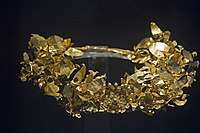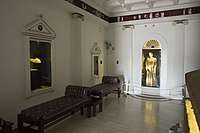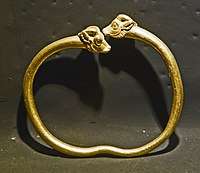Ada of Caria
Ada of Caria (Ancient Greek: Ἄδα) (fl. 377 – 326 BC)[1] was a member of the House of Hecatomnus (the Hecatomnids) and ruler of Caria during the mid-4th century BC, first as Persian Satrap and later as Queen under the auspices of Alexander III (the Great) of Macedon.[2]
| Ada | |
|---|---|
 Portrait of a young woman from the Mausoleum at Halicarnassus, sometimes identified as Ada. British Museum. | |
| Reign | 344–340 BC; 334-326 BC |
| Satrap of Caria | |
| Predecessor | Idrieus |
| Successor | Pixodarus |
| Queen of Caria | |
| Predecessor | Orontobates |
| Successor | Alexander III (the Great) of Macedon |
| Consort | Idrieus |
| House | Hecatomnids |
| Father | Hecatomnus |
| Hecatomnid dynasty (Dynasts of Caria) | ||||||||||||||||
|---|---|---|---|---|---|---|---|---|---|---|---|---|---|---|---|---|
|
||||||||||||||||
History
Ada was the daughter of Hecatomnus, satrap of Caria, and sister of Mausolus, Artemisia, Idrieus, and Pixodarus. She was married to her brother Idrieus, who succeeded Artemisia in 351 BC and died in 344 BC. On the death of her husband Ada became satrap of Caria, but was expelled by her brother Pixodarus in 340 BC, who upon his death in 335 BC was succeeded by his own son-in-law, the Persian Orontobates. Ada fled to the fortress of Alinda, where she maintained her rule in exile.[3]
When Alexander the Great entered Caria in 334 BC, Ada adopted Alexander as her son and surrendered Alinda to him. Alexander accepted her offer and, in return, gave Ada formal command of the Siege of Halicarnassus.[4] After the fall of Halicarnassus, Alexander returned Alinda to Ada and made her queen of all of Caria.[5] Ada's popularity with the populace in turn ensured the Carians' loyalty to Alexander.[2]
"Ada meanwhile held only Alinda, the strongest fortress in Caria; and when Alexander entered Caria she went to meet him, surrendering Alinda and adopting Alexander as her son. Alexander gave Alinda to her charge, and did not reject the title of son, and when he had taken Halicarnassus and became master of the rest of Caria, he gave her command of the whole country."
She was under the protection of Asander, Hellenistic satrap of Lydia.
- Agora of Alinda, Ada's Stronghold.
 The siege and capture of Halicarnassus under Alexander the Great
The siege and capture of Halicarnassus under Alexander the Great
Ada sarcophagus
According to Turkish archaeologists, the tomb of Ada has been discovered, although this claim remains unresolved. Her remains are on display in the archaeological museum of Bodrum.[6]
 Purported skeleton of Ada, Bodrum Museum of Underwater Archaeology
Purported skeleton of Ada, Bodrum Museum of Underwater Archaeology Reconstitution of Ada, Bodrum Museum. She was 1.62m tall, and about 40 years old when she died.
Reconstitution of Ada, Bodrum Museum. She was 1.62m tall, and about 40 years old when she died. Wreath of Ada, Bodrum Museum of Underwater Archaeology
Wreath of Ada, Bodrum Museum of Underwater Archaeology Room dedicated to the Carian Princess in the Bodrum Museum.
Room dedicated to the Carian Princess in the Bodrum Museum. Jewelry worn by the princess in the sarcophagus.
Jewelry worn by the princess in the sarcophagus. Jewelry worn by the princess in the sarcophagus.
Jewelry worn by the princess in the sarcophagus. Reconstitution of the head of the deceased, aged about 40.
Reconstitution of the head of the deceased, aged about 40.
Notes
| Wikimedia Commons has media related to Ada of Caria. |
- 377 BC is the date of her father's death: Gardner, Percy (1918). A History of Ancient Coinage, 700-300 B.C. Clarendon Press: Oxford University. p. 303.
- Fabre-Serris, Jacqueline; Keith, Alison (2015). Women and War in Antiquity. JHU Press. p. 236. ISBN 9781421417622.
- McNicoll, Milner; McNicoll, Anthony; Milner, N. P. (1997). Hellenistic Fortifications from the Aegean to the Euphrates. Clarendon Press. p. 26. ISBN 9780198132288.
- "Geography". Perseus.org. Retrieved 1 May 2015.
- Wikisource:The Anabasis of Alexander/Book I/Chapter XXIII#64
- "Carian Princess Hall". Bodrum Museum of Underwater Archaeology. Retrieved 1 May 2015.
References
- E.D. Carney, "Women and Dunasteia in Caria", American Journal of Philology 126 (2005), pp. 65–91.
- W. Heckel, Who’s Who in the Age of Alexander the Great, Oxford (Blackwell), 2006, p. 3
- Attilio Mastrocinque, La Caria e la Ionia meridionale in epoca ellenistica, 323-188 a. C. (Rome, 1979)
- Stephen Ruzicka, Politics of a Persian dynasty : the Hecatomnids in the fourth century B.C. (1992)
- Simon Hornblower, Mausolus (1982)
- Bean, George E. (1971). Turkey beyond the Maeander. London: Praeger. ISBN 0-87471-038-3.
- Livius, Ada by Jona Lendering
- Ada from Smith, Dictionary of Greek and Roman Biography and Mythology (1867)
- Photos of Halicarnassus Includes a picture of the skeleton of Ada.